| Pages:
1
2
3 |
MineMan
National Hazard
   
Posts: 998
Registered: 29-3-2015
Member Is Offline
Mood: No Mood
|
|
Quote: Originally posted by Hey Buddy  | It's now the next day, I've been testing this stuff this morning and afternoon. I have to say, this is seemingly the most powerful explosive per
volume that I've yet seen. I suspect it's more powerful than the NTz molecules but I don't really know that without direct comparisons of explosive
work. At 10 mg+ tests, this stuff is getting slightly intimidating, approaching small rifle fire, in terms of the perceived impulse. The gas output
itself is relatively low at such small scale but oh boy is it loud and powerful. I believe it is reacting with the aluminum foil in lightly confined
tests. There's no foil left other than where it is clamped in place. I may try a wax witness plate on detonation to see what kind of size the Al foil,
if any, is turned into on detonation. It is possibly vaporizing to Al2O3 or some other mixed product. Wax seems like it could possibly capture foil
particles from small tests to analyze destructive brisance.
I did rudimentary friction and impact tests. I would consider this material insensitive. I generally use PETN as a comparative benchmark and this
material is less sensitive to impact than PETN. In fact, I was unable to detonate samples on an anvil, striking with a 32 oz hammer. I was unable to
set a sample off by 32 oz hammer pressed and dragged across the material on top of anvil steel.
I dont want to talk it up too much, but really can't stress enough how impressive this material detonates. It is so loud and violent and fast. It
definitely creates luminous sparks from the Al foil on detonation when lightly confined.
It appears to be somewhat less flame responsive than I originally had thought. I have attempted some fuze ignitions in foil with simple visco and they
failed to detonate. Probably due to poor heat contact. Those tests were very crude foil/fuze tests, with small masses of the Pb NATz. Not the best
source-study of flame sensitivity but I think it needs a nice hot direct transmission for detonation. If you give it proper heat activation it really
fires. Wow. |
Are there any papers referencing this material or is it an invention of your own? Is this similar to the molecule with 10kms. Excuse me for my poor
memory
|
|
|
dettoo456
Hazard to Others
  
Posts: 178
Registered: 12-9-2021
Member Is Offline
|
|
@Hey Buddy Have you tried isolating the Ni salt of NATz? You mentioned Pb as being more preferable to work with but Ni salts are generally more common
throughout energetics simply due to availability and sensitivity safety. NH2OH or N2H4 might be interesting too - the hydroxylamine salts always seem
to carry the highest performance as non-metallic bases. AgNTz seems like the best bet imo for most applications but you might be on to something with
nitraminotetrazoles. The ANGN route to 5-NATz could be better than 5-ATz & 5-NTz (I haven’t looked at the $/g for either route yet though).
|
|
|
Hey Buddy
Hazard to Others
  
Posts: 384
Registered: 3-11-2020
Location: Bushwhacker Country
Member Is Offline
|
|
Quote: Originally posted by MineMan  | [/rquote]
Are there any papers referencing this material or is it an invention of your own? Is this similar to the molecule with 10kms. Excuse me for my poor
memory |
No problem. --The NATz salts are described by the usual klapotke and shreeve and Lieber did earlier work with it. The metal salts are less explored.
--Semenov is the only reference Ive found on heavy metal salts. His literature doesnt describe any detail on explosive profile. Some of the NATz salts
just burn violently while others explode. They are basically unknown in explosive behavior, but are known about in literature. Definitely not my
invention, just a tetrazole with a nitrimino group. The whole family isnt well explored. The molecule with ~10km velocity is the free acid molecule. I
have attempted that molecule but no success. It is supposedly pretty sensitive to stimuli.
|
|
|
Hey Buddy
Hazard to Others
  
Posts: 384
Registered: 3-11-2020
Location: Bushwhacker Country
Member Is Offline
|
|
Quote: Originally posted by dettoo456  | | Have you tried isolating the Ni salt of NATz? You mentioned Pb as being more preferable to work with but Ni salts are generally more common
throughout energetics simply due to availability and sensitivity safety. |
Excellent idea. After success with Pb Acetate, the acetate route seems useful enough. I have prepared acetates of Co, Zn, Ni and Cu. They are still
evaporating but hopefully done tomorrow.
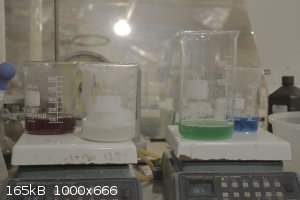
Plan is to run the same procedure on these other metals and see what's found.
Quote: Originally posted by dettoo456  |
NH2OH or N2H4 might be interesting too - the hydroxylamine salts always seem to carry the highest performance as non-metallic bases.
|
NH2OH would be awesome to try. Ive never even seen it. What seems to be the preferable route? NM? I have about a gallon of NM sitting around gathering
dust. Any tips?
Quote: Originally posted by dettoo456  |
AgNTz seems like the best bet imo for most applications but you might be on to something with nitraminotetrazoles. The ANGN route to 5-NATz could be
better than 5-ATz & 5-NTz (I haven’t looked at the $/g for either route yet though). |
I agree AgNTz seems to be the king, it's way too early to say, but this lead salt seems to be more intensive in raw power than Na or Cu NTz. Maybe Im
biased from excitment of learning about new materials--I also do have some silver nitrate around so I could do an Ag salt as well, Im less interested
in silver analogues due to price of silver. But it would be worth a test.
Hopefully some other interesting materials can be found. The Pb is no slouch. I mean, it's ridiculous. -- IMO, ANQ route to NATz is easier than NTz.
You just have to account for losses from NQ->ANQ->NATz. Not sure on cost of production, IMO zinc reduction to AGu is bit of an annoyance and the
calcium hydroxide / urea route is better, but laborious. NATz is easier and quicker.
|
|
|
B(a)P
International Hazard
    
Posts: 1116
Registered: 29-9-2019
Member Is Offline
Mood: Festive
|
|
Maybe it is time to get some in a cavity and punch holes in steel?
Watching your work with great interest, thanks very much!
|
|
|
MineMan
National Hazard
   
Posts: 998
Registered: 29-3-2015
Member Is Offline
Mood: No Mood
|
|
Quote: Originally posted by B(a)P  |
Maybe it is time to get some in a cavity and punch holes in steel?
Watching your work with great interest, thanks very much! |
Seconded! Silver amino tetrazole is too sensitive. What makes this promising is it’s more powerful and less sensitive than the red nickel salt
talked about earlier. Would be really curious to see what 50mg does to a soda can, as that’s the street cred for primaries
|
|
|
Microtek
National Hazard
   
Posts: 828
Registered: 23-9-2002
Member Is Offline
Mood: No Mood
|
|
Remember that the purpose of a primary is not to do work, but rather to initiate secondaries. A better test would be to see how much material is
needed to initiate something moderately sensitive, eg. TNT or plasticized RDX.
Hydroxylamine*HCl is an easy synthesis from nitromethane and hydrochloric acid. Just heat a mix of NM with an excess of aqueous HCl for about 12
hours. You can do it under reflux, or under slight pressure. I suggest beginning at a relatively low temp (maybe 50-70 C) and then raising when the
mix is homogenous (just to decrease the pucker factor).
Then distill of the majority of the water and HCl off and crystallize the product. There are threads about it here on SM.
[Edited on 3-5-2023 by Microtek]
[Edited on 3-5-2023 by Microtek]
|
|
|
Hey Buddy
Hazard to Others
  
Posts: 384
Registered: 3-11-2020
Location: Bushwhacker Country
Member Is Offline
|
|
50 mg fuze failure
I attempted a can test with 50 mg of material, primed with TiH2/KClO4 & NC it was confined in Al foil taped to side of can. It appeared to
deflagrate and didn't detonate. This seems to be a more leaning towards high power secondary explosive with a higher flame sensitivity. Flame
responsiveness is greater than ETN, but much less flame responsive than styphnate, SADS, NAP.
I would consider this a secondary explosive or second stage detonator material. 50 mg was massive compared to the other tests I was doing. It would
have destroyed and separated the can, it was a lot of material. In terms of heating it from underneath in foil confined and unconfined, it reliably
detonates every time. So it detonates over flame more reliably than ETN.
|
|
|
MineMan
National Hazard
   
Posts: 998
Registered: 29-3-2015
Member Is Offline
Mood: No Mood
|
|
Quote: Originally posted by Hey Buddy  | I attempted a can test with 50 mg of material, primed with TiH2/KClO4 & NC it was confined in Al foil taped to side of can. It appeared to
deflagrate and didn't detonate. This seems to be a more leaning towards high power secondary explosive with a higher flame sensitivity. Flame
responsiveness is greater than ETN, but much less flame responsive than styphnate, SADS, NAP.
I would consider this a secondary explosive or second stage detonator material. 50 mg was massive compared to the other tests I was doing. It would
have destroyed and separated the can, it was a lot of material. In terms of heating it from underneath in foil confined and unconfined, it reliably
detonates every time. So it detonates over flame more reliably than ETN. |
Thank you Buddy!
I have an easy solution. Mix 10-20mg of Ni amino guanidine P with 50mg of this molecule and test again. To me this is promising, as excessive flame
sensitivity indicates all other sensitivities.
Will you please try it using this method and compare the 50mg can to 50mg can of the nickel red?
|
|
|
Hey Buddy
Hazard to Others
  
Posts: 384
Registered: 3-11-2020
Location: Bushwhacker Country
Member Is Offline
|
|
50 mg Pb NATz, low density. 10 mg NAP low density prime. Two layers standard Al foil confinement
Didnt quite separate the can like I predicted, but it did fold it in which is neato.
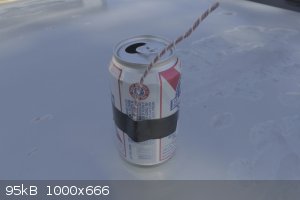 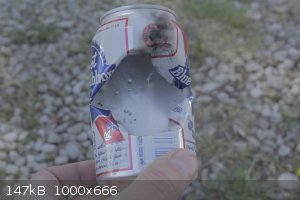 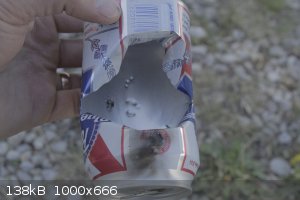 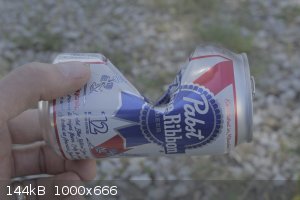 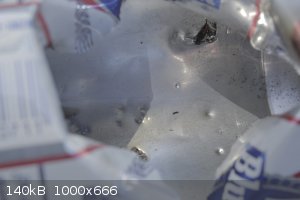
|
|
|
Hey Buddy
Hazard to Others
  
Posts: 384
Registered: 3-11-2020
Location: Bushwhacker Country
Member Is Offline
|
|
I didnt read your request carefully, that last test was just sprinkled in Al foil and then NAP sprinkled at the top where fuze contacts, not mixed,
just fyi. --I just reread. I will now go do a 50 mg NAP can test...standby
[Edited on 3-5-2023 by Hey Buddy]
|
|
|
Hey Buddy
Hazard to Others
  
Posts: 384
Registered: 3-11-2020
Location: Bushwhacker Country
Member Is Offline
|
|
60 mg NAP hand pressed, no prime, visco, 2 layers standard Al foil confinement
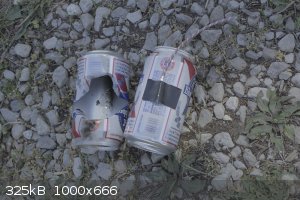 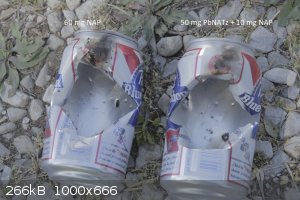 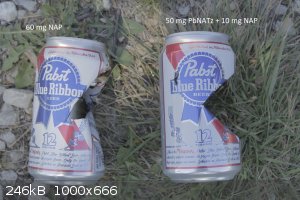
[Edited on 3-5-2023 by Hey Buddy]
|
|
|
MineMan
National Hazard
   
Posts: 998
Registered: 29-3-2015
Member Is Offline
Mood: No Mood
|
|
Thank you! Really impressive all it needs is 10mg of NAP. This seems to be the perfect primary. My guess, is confined in a 1mm aluminum tube it will
DDT every time. This could be quite the discovery! Congrats Buddy!
|
|
|
Hey Buddy
Hazard to Others
  
Posts: 384
Registered: 3-11-2020
Location: Bushwhacker Country
Member Is Offline
|
|
Transition metals 5-NATz
I have attempted displacement and isolation by Cu, Ni, Zn and Co AcO. All of them successfully displace easily. Cu, Zn, and Co become opaque by the
end of complexing. The Ni is curious, in that it becomes a translucent purple like grape kool aide and on sitting it appears to precipitate a fine
white powder to the bottom of the beaker but it is easily redissolved in the H2O and was entirely lost on filtering. I made a fresh batch of Na NATZ
tonight and will attempt the Nickel again with cooling and decanting?
These salts are drying and will be processed for data probably not tomorrow but day after. I will also attempt a calcium and barium salt. I do have
weird metals that could be attempted. I have vanadium, antimony and bismuth. Not really sure if any of those would be worth trying? I have a suspicion
on the Ca salt that forms hydrates, I believe it can double complex with a Cu or Ni to be a CuCa/NiCa salt which may alter the hygroscopic properties.
I wish I understood complexation more precisely to understand what is really going on.
Does anyone know what the likely complex would be for Zn, Ni, Co? If they would complex as 1,2, or 3 NATz? Cu is listed in semenov as complexing as
one NATz per Cu and dec at 240 C
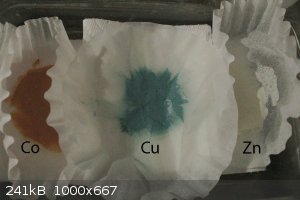
[Edited on 4-5-2023 by Hey Buddy]
UPDATE:
I have been a bit distracted, but I did test these materials today for burn and hammer. They are all explosive and fairly mechanically insensitive.
The Zn and Cu seemed a bit slow and low powered. The Co reminded me a of some tetrazoles with micro popping on flame.
It appears at first glance that Pb NATz is superior. Ag makes sense to attempt I suppose. It also makes sense to test Ca, Ba, and Sr, as those may
possess some power. And of course try to isolate the Ni. --If the Ca salt is hygroscopic but detonates well, a co-metal salt might alter that
hygroscopicity.
I made small batches enough to test basic properties to probe the materials. I will do a side by side between the materials to measure performance at
small mass.
I have found a better medium than an aluminum can for small det tests...believe it or not, a grocery store standard food can works pretty well. @ 25
mg to 75 mg detonations, it causes formations without blowing apart the can and it leaves very clear and measurable indentations on the inner radius
that can be calipered or just eye balled. It seems fairly sensitive to the force work of small detonations. In testing this, the charge weight was
changed by 5 mg in a series of 4 on a can, the resulting dents are relatively scaled and resolved enough to tell the difference between ~5mg changes.
I also tested the Glycine perchlorate (made by displacement with NH4ClO4) on this preliminary can test and can confirm that NAP @ 10 mg can detonate
Glycine Perchlorate in 50 mg mass in a hand pressed column @ ~5/6mm diameter. I thought that was interesting. makes glycine perchlorate even more
interesting, as it is a simply made melt cast, low critical diameter explosive. Purported to be 8km+ Vd. Even if 8 km were inaccurate and its Vd were
a lot lower in the 7km range, it is still greater pressure, velocity and prepared much, much more simply than legacy TNT. All very exciting stuff.
Having lots of fun with this stuff.
[Edited on 5-5-2023 by Hey Buddy]
[Edited on 5-5-2023 by Hey Buddy]
|
|
|
Hey Buddy
Hazard to Others
  
Posts: 384
Registered: 3-11-2020
Location: Bushwhacker Country
Member Is Offline
|
|
Quote: Originally posted by Microtek  |
Hydroxylamine*HCl is an easy synthesis from nitromethane and hydrochloric acid. Just heat a mix of NM with an excess of aqueous HCl for about 12
hours. You can do it under reflux, or under slight pressure. I suggest beginning at a relatively low temp (maybe 50-70 C) and then raising when the
mix is homogenous (just to decrease the pucker factor).
Then distill of the majority of the water and HCl off and crystallize the product. There are threads about it here on SM.
|
This is what I was interested to know. I'm doing it in my mind right now. Thank you Microtek
|
|
|
Hey Buddy
Hazard to Others
  
Posts: 384
Registered: 3-11-2020
Location: Bushwhacker Country
Member Is Offline
|
|
Pb vs Co vs Cu vs Zn
50 mg loads of CoNATz, CuNATz, ZnNATz and PbNATz were fired at ~90 degrees from each other along the mid circumference of a food can.
All were lightly hand tamped in Al foil in a standard diameter of ~5mm.
All were primed with 10 mg NAP.
The order from smallest impression to the largest is Zn<Cu<Co/Pb
Co did make a greater impression in the can than Pb on this sample. In my judgement, this is probably an anomaly. PbNATz seems noticeably more
powerful than Co, although Co is also powerful.
Zn and Cu were noticeably less powerful in all testing. Co and Zn both seem to have a tendency of micro detonations.
The Zn test didn't have a full detonation as micro pops could be heard after the main load was fired. I believe despite this, it still seems like Zn
is the least powerful, with Cu also somewhat anemic compared to Pb.
Pb and Co are down selected for next stage testing against Ag, Ba, Sr, Ca. Hg is purportedly an effective primary explosive according to semenov. This
is the only material he describes as a primary explosive.
I don't plan to test Hg analogue.
Hg is probably one of the least desirable cations for explosives in general, due to the hazard of Hg and it's lower availability.
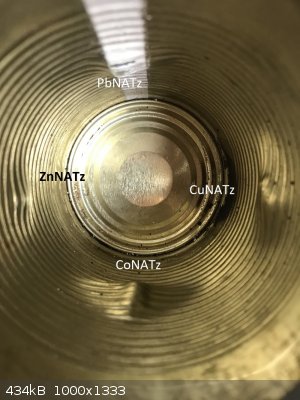
[Edited on 5-5-2023 by Hey Buddy]
|
|
|
MineMan
National Hazard
   
Posts: 998
Registered: 29-3-2015
Member Is Offline
Mood: No Mood
|
|
This is exciting
|
|
|
Hey Buddy
Hazard to Others
  
Posts: 384
Registered: 3-11-2020
Location: Bushwhacker Country
Member Is Offline
|
|
Camera broke
Ca, Sr, Ba, Ag salts are made.
Ca(OH)2, Sr(NO3)2, Ba(NO3)2, Ag(NO3).
Sr reaction is translucent similar to Ni attempt.
All other metals opacified in 5 minutes or so on reaction @ 70 C.
Going to be using cell phone pics for follow up.
[Edited on 6-5-2023 by Hey Buddy]
|
|
|
Hey Buddy
Hazard to Others
  
Posts: 384
Registered: 3-11-2020
Location: Bushwhacker Country
Member Is Offline
|
|
Quote: Originally posted by Microtek  | Remember that the purpose of a primary is not to do work, but rather to initiate secondaries. A better test would be to see how much material is
needed to initiate something moderately sensitive, eg. TNT or plasticized RDX.
|
This is true. The ONLY purpose of primaries is initiation.
Other tangential interests of primries include:
-Simplicity of preparation
-Sympathetic detonation
-Critical mass/diameter
I will continue can impression down selection.
From those results of seemingly most-brisant NATz compounds, I will further test initiation ability.
Do you think RDX is better test than PETN? I have PETN already, but no RDX prepared. I could prepare plasticized RDX but which one? C4 analogue?
|
|
|
Microtek
National Hazard
   
Posts: 828
Registered: 23-9-2002
Member Is Offline
Mood: No Mood
|
|
You can use PETN as well. The point is simply that if the secondary is very easy to initiate, even a poor primary will work (eg. nitroglycerine can be
initiated with blackpowder), so it will be difficult to get reliable data. So you need to make it challenging for the primary. Fortunately this can be
accomplished by using more inerts in your PETN. You could start with maybe 20 % inerts, made up of either the binder/plasticizer system plus CaCO3 or
other suitable material, or possibly the binder/plasticizer could account for all of the inerts.
|
|
|
Hey Buddy
Hazard to Others
  
Posts: 384
Registered: 3-11-2020
Location: Bushwhacker Country
Member Is Offline
|
|
Metal Nitrimino Tetrazoles continued...
Ba, Sr, Ag all displaced successfully, Ca is inert, which seems like it has some error in preparation, as CaNATz should be explosive.
The other three salts were dried gently and probed for flame responsive detonation. Ba and Sr gave micro popping on burning.
Ba pops were the strongest but there was no observed detonation.
Ag deflagrates.
These salts as tested, should all be in their hydrated forms with whatever crystal water they have. Presumably if heated, they would become anhydrous
which would make them more sensitive and easier to achieve detonation. The Barium and Calcium salt are both known to have different performances and
sensitivities in hydrated form versus anhydrous.
Barium is reported in literature to be dehydrated at 200 C.
Of all these salts, so far, the Pb clearly stands apart. It has an interesting profile:
Pb 5-NATz
1) It detonates on flame over foil
2) it does not DDT, but deflagrates on a visco fuze
3) it is insensitive to friction and impact
4) it is obviously very powerful as a primary explosive
5) Tiny critical mass threshold of detonation
There is an obvious question of if the Pb NATz (being natively a tetra-hydrate) can lose water of crystallization, how far would it change its
profile? It is worth looking into but I suspect with the insensitivity combined with high power and easy detonation, the hydrate could be more
desirable. Anhydrous could potentially be even more powerful though...
I have not yet re attempted nickel. To be honest, I'm now thinking about formic acid condensation to triazole... I assume some sort of nitro amino
triazole.
If a primary explosive could be found in that family, it would simplify precursors eliminating the need of nitrite and requiring only formic acid.
I plan a reattempt of the Ni, and probing if it's possible to dehydrate the Pb, but I'm looking forward to potential Triazole condensation salts with
similar metal cations. Pb NATz will get further testing to probe initiating ability. I intend to use RDX and PETN as the standards. Hopefully an
interesting triazole can be found.
|
|
|
underground
National Hazard
   
Posts: 697
Registered: 10-10-2013
Location: Europe
Member Is Offline
|
|
I am not a chemist but i got a bunch of diaminourea and was thinking if DAU will react with Nano2 the same way as ANG to form tetrazoles. Maybe an
urea tetrazole based ?
[Edited on 8-5-2023 by underground]
|
|
|
Hey Buddy
Hazard to Others
  
Posts: 384
Registered: 3-11-2020
Location: Bushwhacker Country
Member Is Offline
|
|
It should respond by cyclization and also respond to other things like formic acid too. Personally, I don't know what form the urea
semicarbazide/carbohydrazide cyclizes into with NaNO2. It could be a triazole or a tet. Im sure someone will know. I think NTO is from semicarbazide
cyclization, If I'm not mistaken.
|
|
|
Hey Buddy
Hazard to Others
  
Posts: 384
Registered: 3-11-2020
Location: Bushwhacker Country
Member Is Offline
|
|
Formic Acid Cyclization is simple
I have now prepared the cyclization product of ANQ + HCOOH several times.
It's straight forward and provides good yield.
It is sort of a boring less-chromatic color change so I will spare the photos.
ANQ is dissolved in water and heated to 70 C on stirring.
My ANQ was crude, thus imparting an orange tint to the solution.
At 70 C formic acid at 2x molar excess was added drop wise.
I'm not certain if a 2x excess is appropriate, it may create a formate, which may not be desirable. This is simply an account of what was done. First,
equal molar formic acid was added, then as the reaction seemed slow, more was added.
The solution loses some color turning more-white.
The solution undergoes a mass change and becomes slightly more volumous.
In my case, the mass change started to cause the material to rise out of the solution, so more water was added to keep everything in solution.
I was undecided about the time needed for the reaction, so I left the solution to stir at 70 C for 20 minutes.
The azole condensed product was filtered and washed with cold water.
The material is white after filtering and loses all orange tint from crude ANQ.
I'm uncertain of this material's exact identity. I believe it may be a Nitro Amino Triazole. I believe this material will complex not only with metals
but possibly oxidizers too. I dont know the weight of this molecule and so I will be attempting complexing in excess with the metal cations.
I am going to repeat this formic acid +ANQ cyclization with strictly stoichiometric formic acid to identify if any difference presents itself between
the two products.
[Edited on 9-5-2023 by Hey Buddy]
|
|
|
Microtek
National Hazard
   
Posts: 828
Registered: 23-9-2002
Member Is Offline
Mood: No Mood
|
|
Take a look at the attached paper. It seems that ANQ does indeed form 5-nitramino-1,2,4-triazole with formic acid.
Another interesting possibility would be oxalic acid which might form a bicyclic bis(5-nitraminotriazole).
They are said to be fairly strong acids, so you might want to make some ammonium-, hydrazinium- or hydroxylammonium salts...
Attachment: kurzer1963.pdf (1.6MB)
This file has been downloaded 145 times
|
|
|
| Pages:
1
2
3 |